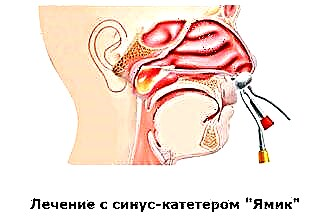Hyperemia of the mucous membrane of the throat is a sign that signals the presence of inflammation in the ENT organs. Pathological processes in tissues arise in response to local damage to the ciliated epithelium by pathogens, physical, psychogenic or chemical stimuli.
 How to treat a red throat in a child? The principles of therapy depend on the intensity, prevalence and causes of inflammation in the tissues. In most cases, hyperemia of the mucous membranes is due to the development of an infectious flora, represented by pathogenic microbes, fungi or viruses.
How to treat a red throat in a child? The principles of therapy depend on the intensity, prevalence and causes of inflammation in the tissues. In most cases, hyperemia of the mucous membranes is due to the development of an infectious flora, represented by pathogenic microbes, fungi or viruses.
To stop undesirable processes in the respiratory organs, drugs of etiotropic and symptomatic therapy allow. In this case, the choice of suitable drugs can only be determined by a specialist after an accurate diagnosis has been made.
Pathophysiology of inflammation
Inflammation is the body's response to soft tissue damage, which is aimed at eliminating damaging factors and restoring the integrity of the mucous membranes of the throat. A characteristic manifestation of catarrhal processes in the ENT organs are changes in the microvasculature, which cause excessive blood filling of the ciliated epithelium.
Pathological processes in the respiratory organs are caused by the negative impact of phlogogenic stimuli, which are conventionally divided into two categories:
- exogenous - viruses, protozoa, parasites, microbes, fungi, chemical burns, allergens;
- endogenous - decay products of soft tissues, neoplasms, salt deposits, hemorrhages.
Sore throat is a general pathological process, in the development of which the following factors play a special role:
- changes in metabolic processes;
- violation of blood microcirculation;
- destruction of pathogens by macrophages;
- sweating inflammatory fluid;
- multiplication of cells of epithelial tissues (proliferation).
Catarrhal inflammation is one of the protective and adaptive reactions that stimulate the immune system. The delimitation of the affected tissue sites facilitates the process of elimination of pathogens and, accordingly, foci of inflammation.
Provocateurs and pathogens of infection
 Hyperemia of the pharynx and adjacent tissues in most cases is due to septic inflammation. Infectious diseases provoke a change in the morphological structure of the ciliated epithelium, resulting in unpleasant symptoms - redness, sore throat and sore throat.
Hyperemia of the pharynx and adjacent tissues in most cases is due to septic inflammation. Infectious diseases provoke a change in the morphological structure of the ciliated epithelium, resulting in unpleasant symptoms - redness, sore throat and sore throat.
ENT organs can become inflamed due to the intensive development of opportunistic microorganisms, which include:
- adenoviruses;
- herpes viruses;
- rhinoviruses;
- coronaviruses;
- influenza virus;
- staphylococci;
- meningococci;
- streptococci;
- haemophilus influenzae;
- yeast and mold fungi.
Young children get colds more often than adults, since they have practically no acquired immunity.
The reproduction of pathogenic flora in the respiratory organs is facilitated by a decrease in local and general immunity. The weakening of the body's immune defenses is most often associated with local hypothermia, antibiotic abuse, mechanical damage to the mucous membranes, chronic diseases, etc. Before prescribing treatment, it is necessary to find out exactly the reasons for the development of catarrhal processes in the airways. To do this, the child needs to undergo differential diagnosis from a specialist who can determine the nature of the causative agent of the infection and the optimal treatment of ENT disease.
List of possible diseases
Most often, parents prefer to treat a red throat in their children without the help of a doctor. However, self-treatment can worsen well-being and provoke complications.
 The symptoms of bacterial and viral inflammation are similar, but the treatment principles for each can be very different. The following types of diseases can be the cause of redness of the mucous membrane of the throat:
The symptoms of bacterial and viral inflammation are similar, but the treatment principles for each can be very different. The following types of diseases can be the cause of redness of the mucous membrane of the throat:
- catarrhal pharyngitis;
- chicken pox;
- catarrhal sore throat;
- rubella;
- diphtheria;
- allergy;
- flu;
- measles.
All of the above diseases are characterized by inflammation and hyperemia of the mucous membrane of the oropharynx. The type of disease can be determined by concomitant symptoms, localization of foci of inflammation in the airways and the presence of complications. Timely passage of therapy allows you to quickly eliminate the pathological flora in the affected organs and accelerate recovery.
It should be noted that a sore throat in a child is not always caused by the development of pathogens. Hyperemia of the pharynx and lymphoid tissues of the pharynx can be associated with teething, diseases of the gastrointestinal tract and unfavorable ecology.
When to see a doctor?
Inadequate treatment of infections can cause serious complications. Therefore, if symptoms of an ENT disease are detected, it is undesirable to postpone a visit to a pediatrician or otolaryngologist. Due to the reduced reactivity of the body, pathological processes in the respiratory organs are rapidly progressing, causing inflammation of neighboring organs. In addition, the metabolites of pathogens create an excessive burden on the detoxification organs, which can lead to the development of renal failure.
The reason for seeking help from a specialist is:
- hyperthermia for 3-4 days;
- pain in the throat when swallowing saliva;
- changes in the structure of the mucous membranes;
- swelling of the tongue;
- labored breathing;
- enlarged lymph nodes;
- swelling of the mucous membranes of the throat;
- persistent cough and rhinitis;
- hypertrophy of the palatine tonsils.
Difficulty breathing may indicate obstruction of the bronchi and a decrease in the inner diameter of the throat, which is fraught with the development of hypoxia.
Catarrhal pharyngitis
 Catarrhal pharyngitis is a non-suppurative inflammation of the lymphoid tissues of the pharynx, accompanied by pain when swallowing and hyperthermia. A reddened pharynx indicates excessive blood filling of the mucous membranes, which is most often associated with septic inflammation.
Catarrhal pharyngitis is a non-suppurative inflammation of the lymphoid tissues of the pharynx, accompanied by pain when swallowing and hyperthermia. A reddened pharynx indicates excessive blood filling of the mucous membranes, which is most often associated with septic inflammation.
The causative agents of catarrhal pharyngitis are pathogenic viruses (adenoviruses, influenza virus), so the disease often develops against the background of a runny nose or sinusitis. Acute pharyngitis develops mainly after exposure to aggressive factors on the throat tissue - polluted air, hot steam, volatile chemicals, etc.
Typical clinical manifestations of the disease in children include:
- perspiration and pain in the throat;
- subfebrile fever;
- persistent cough;
- muscle weakness;
- lack of appetite.
Inadequate treatment of pharyngitis in children contributes to the spread of pathogenic flora and the development of tracheitis.
Redness of the throat in a child causes tissue edema, as a result of which there is a coma syndrome in the pharynx. Untimely treatment of pathology increases the risk of bacterial infection and, accordingly, chronicization of pathological processes. As a rule, a white coating on the palatine arches and the back of the throat indicates the presence of purulent inflammation. If such symptoms are found, you need to seek help from a pediatrician.
Catarrhal sore throat
Catarrhal sore throat is a pathology in which there is inflammation of the components of the lymphadenoid pharyngeal ring. ENT disease is characterized by swelling of the palatine arches and diffuse hyperemia of lymphoid formations (glands).The incubation period for the development of pathogens is on average 1-2 days, after which the child acutely feels very severe sore throat while swallowing saliva.
 As a rule, the causative agents of infection are bacteria, less often viruses and yeast-like fungi. The rapid development of pathogenic flora in lymphoid tissues leads to inflammation of the mucous membranes and the formation of mucous exudate on the surface of the palatine tonsils. Children with catarrhal angina complain about:
As a rule, the causative agents of infection are bacteria, less often viruses and yeast-like fungi. The rapid development of pathogenic flora in lymphoid tissues leads to inflammation of the mucous membranes and the formation of mucous exudate on the surface of the palatine tonsils. Children with catarrhal angina complain about:
- perspiration and burning sensation in the throat;
- dry mucous membranes;
- myalgia and lack of appetite;
- headache;
- subfebrile fever;
- soreness of regional lymph nodes.
On visual examination, all components of the pharyngeal ring are hyperemic, and the palatine arches and tonsils are covered with mucopurulent exudate. Over the next 2-3 days, a white coating appears on the root of the tongue and the back of the throat. Cervical and submandibular lymph nodes increase slightly in size.
Viral forms of tonsillitis are more often diagnosed in children under the age of 3-4 years, bacterial - after 5 years.
Angina is a dangerous disease that can cause local and systemic complications. Hypertrophy of the tonsils and severe swelling of the mucous membranes block the airways, making breathing difficult.
Untimely elimination of pathogenic flora contributes to the progression of the disease and the development of paratonsillar abscess.
Rubella
Rubella is a highly contagious viral disease, the development of which is signaled by the appearance of a morbiliform rash on the body. Within a week after infection, there is a moderate increase in temperature, conjunctivitis and all signs of pharyngitis development. Most often, the disease occurs in unvaccinated children aged 2 to 10 years.
 In immunocompromised children, rubella causes serious complications: pneumonia, arthritis, and thrombocytopenic purpura.
In immunocompromised children, rubella causes serious complications: pneumonia, arthritis, and thrombocytopenic purpura.
The rubella virus enters the child's respiratory system through the mucous membranes of the oropharynx. With the blood flow, pathogens are spread throughout the body, provoking an increase in the cervical lymph nodes. In the first few days after infection, multiple rashes form on the back, buttocks and behind the ears. If the child has a red throat and all signs of rubella development, it is necessary to seek help from a specialist as soon as possible.
Diphtheria
Diphtheria is a bacterial inflammation of the oropharynx, in which the mucous membranes of the bronchi and larynx are affected. The severity of ENT disease is due to the toxic effects of the causative agent of the infection - diphtheria bacillus. In addition to the general symptoms of intoxication, blockage of the airways with edema and a diphtheria film often occurs.
With the development of diphtheria, the following symptomatic picture is observed:
- severe weakness;
- swelling and hyperemia of the pharynx;
- membranous plaque on the tonsils;
- difficulty swallowing;
- discomfort in the throat;
- pallor of the skin;
- lymph node hypertrophy.
In 95% of cases, children are diagnosed with diphtheria of the oropharynx, in which the general symptoms of intoxication are weak. A red throat in a child signals the location of the pathological flora. In addition to the oropharynx, diphtheria bacillus can affect the conjunctiva of the eye, the mucous membrane of the nose and genitals. Diphtheria bacillus secretes toxins that can lead to neurosis of the ciliated epithelium, myocarditis and damage to peripheral nerves.
Flu
 If a child has a persistent red throat, this could signal the development of influenza. The disease is triggered by the influenza virus, which mainly affects the mucous membranes of the respiratory system. Very often, the word "flu" is called all types of respiratory diseases, which is fundamentally wrong. In addition to influenza, there are at least 200 viral pathologies that are treated with fundamentally different medicines.
If a child has a persistent red throat, this could signal the development of influenza. The disease is triggered by the influenza virus, which mainly affects the mucous membranes of the respiratory system. Very often, the word "flu" is called all types of respiratory diseases, which is fundamentally wrong. In addition to influenza, there are at least 200 viral pathologies that are treated with fundamentally different medicines.
Clinical signs of the development of infection are not specific, therefore, it is almost impossible to establish the true cause of inflammation of the oropharynx without carrying out the necessary laboratory tests.
In practice, the diagnosis is often made on the basis of epidemic data indicating the incidence of ARVI in the population.
Typical manifestations of influenza infection are:
- heat;
- chills;
- myalgia;
- headache;
- hyperemia of the pharynx;
- runny nose;
- tense cough;
- swelling of the pharyngeal mucosa.
A severe form of the disease can provoke the development of vascular collapse, in which the blood supply to vital organs deteriorates.
If complications develop, the paranasal sinuses, the Eustachian tube and, as a result, the tympanic cavity can become inflamed. If a child complains not only of general malaise, but also "lumbago" in the ears, it is impossible to postpone the visit to the otolaryngologist. Untimely relief of catarrhal processes can lead to the development of otitis media, meningitis and other serious diseases.
Other reasons
 A red throat in a child does not always indicate septic inflammation of the ciliated epithelium and lymphoid tissues. Hyperemia is a consequence of excessive blood vessels filling in the airways, which may be associated with irritation of the mucous membranes. In some cases, swelling and redness of the throat is due to the following reasons:
A red throat in a child does not always indicate septic inflammation of the ciliated epithelium and lymphoid tissues. Hyperemia is a consequence of excessive blood vessels filling in the airways, which may be associated with irritation of the mucous membranes. In some cases, swelling and redness of the throat is due to the following reasons:
- teething - vertical movement of teeth, accompanied by a violation of the integrity of the gums, leads to loosening of the mucous membranes and, as a result, a violation of the secretory function of the ciliated epithelium;
- allergy - an increase in the body's sensitivity to the effects of allergens, which include food, medicines, toothpaste, etc.; provokes redness and swelling of the mucous membranes of the respiratory system;
- gastroesophageal reflux - disruptions in the functioning of the esophageal sphincter, leading to the reflux of the contents of the stomach into the airways; acids provoke irritation of the mucous membranes, as a result of which aseptic inflammation occurs;
- adenoiditis - catarrhal inflammation of the hypertrophied pharyngeal tonsil, accompanied by damage to the lymphoid tissues of the pharynx.
When the throat is red, hyperemia of the mucous membrane of the oropharynx may be a manifestation of a psychosomatic illness. Emotional stress, constant anxiety, fear and stress create excessive stress on the nervous system. As a result, there are disturbances in the functioning of the autonomic nervous system, which can lead to dysfunction of the respiratory system, gastrointestinal tract and even the cardiovascular system.
It is possible to eliminate redness in the throat only after determining the causes of the problem. In case of timely referral to a specialist, treatment is limited to pharmacotherapy with anti-inflammatory and analgesic drugs. Depending on the nature of the pathogen, antiviral, antibacterial or antifungal drugs are used to treat infectious diseases.



